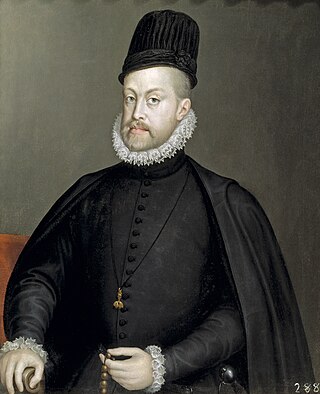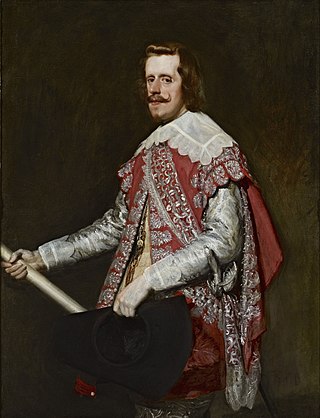
The House of Habsburg, also known as the House of Austria, is one of the most prominent and important dynasties in European history.

Philip II, also known as Philip the Prudent, was King of Spain from 1556, King of Portugal from 1580, and King of Naples and Sicily from 1554 until his death in 1598. He was also jure uxoris King of England and Ireland from his marriage to Queen Mary I in 1554 until her death in 1558. He was also Duke of Milan from 1540. From 1555, he was Lord of the Seventeen Provinces of the Netherlands.

Philip III was King of Spain. As Philip II, he was also King of Portugal, Naples, Sicily and Sardinia and Duke of Milan from 1598 until his death in 1621.

Philip IV, also called the Planet King, was King of Spain from 1621 to his death and King of Portugal from 1621 to 1640. Philip is remembered for his patronage of the arts, including such artists as Diego Velázquez, and his rule over Spain during the Thirty Years' War.

Albert VII was the ruling Archduke of Austria for a few months in 1619 and, jointly with his wife, Isabella Clara Eugenia, sovereign of the Habsburg Netherlands between 1598 and 1621. Prior to this, he had been a cardinal, Archbishop of Toledo, viceroy of Portugal and Governor General of the Habsburg Netherlands. He succeeded his brother Matthias as reigning archduke of Lower and Upper Austria, but abdicated in favor of Ferdinand II the same year, making it the shortest reign in Austrian history.
Duke of Burgundy was a title used by the rulers of the Duchy of Burgundy, from its establishment in 843 to its annexation by France in 1477, and later by Holy Roman Emperors and Kings of Spain from the House of Habsburg who claimed Burgundy proper and ruled the Burgundian inheritance in the Low Countries.

The Treaty of London, signed on 18 August O.S. 1604, concluded the nineteen-year Anglo-Spanish War. The treaty restored the status quo between the two nations. The negotiations probably took place at Somerset House in Westminster and are sometimes known as the Somerset House Conference.

Isabella Clara Eugenia, sometimes referred to as Clara Isabella Eugenia, was sovereign of the Spanish Netherlands in the Low Countries and the north of modern France with her husband, Archduke Albert VII of Austria.

The Eighty Years' War or Dutch Revolt was an armed conflict in the Habsburg Netherlands between disparate groups of rebels and the Spanish government. The causes of the war included the Reformation, centralisation, taxation, and the rights and privileges of the nobility and cities.

Habsburg Spain is a contemporary historiographical term referring to the huge extent of territories ruled between the 16th and the 18th centuries (1516–1700) by kings from the Spanish branch of the House of Habsburg. Habsburg Spain was a composite monarchy and a personal union. The Habsburg Spanish monarchs reached the zenith of their influence and power ruling the Spanish Empire. Spain, or "the Spains", referring to Spanish territories across different continents in this period, initially covered the entire Iberian peninsula, including the crowns of Castile, Aragon and from 1580 Portugal. It then expanded to include territories over the five continents, consisting of much of Latin America and the West Indies in the Americas, the Low Countries, Belgium, Luxembourg, Italian territories and France in Europe, Portuguese possessions such as small enclaves like Ceuta and Oran in North Africa, and the Philippines and other possessions in Southeast Asia. The period of Spanish history has also been referred to as the "Age of Expansion".

The Peace of Münster was a treaty between the Lords States General of the Seven United Netherlands and the Spanish Crown, the terms of which were agreed on 30 January 1648. The treaty, negotiated in parallel to, but not part of, the Peace of Westphalia, is a key event in Dutch history, marking the formal recognition of the independent Dutch Republic and the end of the Thirty Years' War and the Eighty Years' War.

The Twelve Years' Truce was a ceasefire during the Eighty Years' War between Spain and the Dutch Republic, agreed in Antwerp on 9 April 1609 and ended on 9 April 1621. While European powers like France began treating the Republic as a sovereign nation, the Spanish viewed it as a temporary measure forced on them by financial exhaustion and domestic issues and did not formally recognise Dutch independence until the Treaty of Westphalia in 1648. The Truce allowed Philip III of Spain to focus his resources elsewhere, while Archdukes Albert and Isabella used it to consolidate Habsburg rule and implement the Counter-Reformation in the Southern Netherlands.

The Franco-Spanish War (1635–1659) was fought between France and Spain with the participation of a changing list of allies throughout the war. The first phase, beginning in May 1635 and ending with the 1648 Peace of Westphalia, is considered a related conflict of the Thirty Years' War. The second phase continued until 1659, when France and Spain agreed to peace terms in the Treaty of the Pyrenees.

Gaspar de Guzmán y Pimentel, 1st Duke of Sanlúcar, 3rd Count of Olivares,, known as the Count-Duke of Olivares, was a Spanish royal favourite of Philip IV and minister. Appointed as Grandee on 10 April 1621, a day after the ending of the Twelve Years' Truce to January 1643, he over-exerted Spain in foreign affairs and unsuccessfully attempted domestic reform. His policy of committing Spain to recapture Holland led to a renewal of the Eighty Years' War while Spain was also embroiled in the Thirty Years' War (1618–1648). In addition, his attempts to centralise power and increase wartime taxation led to revolts in Catalonia and in Portugal, which brought about his downfall.
The Palatinate campaign, also known as the Spanish conquest of the Palatinate or the Palatinate phase of the Thirty Years' War was a campaign conducted by the Imperial army against the Protestant Union in the Lower Palatinate, during the Thirty Years' War.

Jean Grusset dict Richardot, knight was a statesman and diplomat from the Franche-Comté, who held high political office during the Dutch Revolt and played an important role in restoring Habsburg rule in the Southern Netherlands.

Habsburg Spain was at the height of its power and cultural influence at the beginning of the 17th century, but military, political, and economic difficulties were already being discussed within Spain. In the coming decades these difficulties grew and saw France gradually taking Spain's place as Europe's leading power through the later half of the century. Many different factors, including the decentralized political nature of Spain, inefficient taxation, a succession of weak kings, power struggles in the Spanish court and a tendency to focus on the American colonies instead of Spain's domestic economy, all contributed to the decline of the Habsburg rule of Spain.

The years 1621–1648 constituted the final phase of the Eighty Years' War between the Spanish Empire and the emerging Dutch Republic. It began when the Twelve Years' Truce (1609–1621) expired, and concluded with the Peace of Münster in 1648.

The years 1599–1609 constituted a phase of in the Eighty Years' War between the Spanish Empire and the emerging Dutch Republic. It followed the Ten Years (1588–1598) that saw significant conquests by the Dutch States Army under the leadership of stadtholders Maurice of Nassau and William Louis of Nassau-Dillenburg, and ended with the conclusion of the Twelve Years' Truce (1609–1621) on 9 April 1609. The 1599–1609 period was generally marked by a stalemate; the well-known Battle of Nieuwpoort (1600) brought the Dutch a tactical victory without long-term gain, while Spanish conquests in the Siege of Ostend (1601–1604) and Spinola's 1605–1606 campaign were effectively balanced out by the Dutch naval triumph in the Battle of Gibraltar (1607) and the Spanish state bankruptcy that same year. Financial troubles were amongst the primary motives that prompted the Dutch, and even more so the Spanish, to head to the negotiating table for a ceasefire.

















